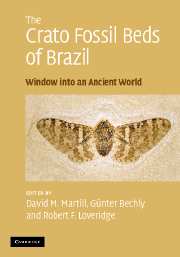Book contents
- Frontmatter
- Contents
- Contributors
- Preface
- Acknowledgements
- Part I The Crato Formation Konservat Lagerstätte
- Part II The invertebrate fauna
- 7 Taphonomy and preservation of Crato Formation arthropods
- 8 Chilopoda: centipedes
- 9 Arachnida: spiders, scorpions and allies
- 10 Crustacea of the Crato Formation
- 11 Insects of the Crato Formation
- Part III The vertebrate fauna
- Part IV The flora
- Part V Miscellanea
- Appendix: species list for the Crato Formation
- Systematic index
- Plate section
- References
7 - Taphonomy and preservation of Crato Formation arthropods
Published online by Cambridge University Press: 22 August 2009
- Frontmatter
- Contents
- Contributors
- Preface
- Acknowledgements
- Part I The Crato Formation Konservat Lagerstätte
- Part II The invertebrate fauna
- 7 Taphonomy and preservation of Crato Formation arthropods
- 8 Chilopoda: centipedes
- 9 Arachnida: spiders, scorpions and allies
- 10 Crustacea of the Crato Formation
- 11 Insects of the Crato Formation
- Part III The vertebrate fauna
- Part IV The flora
- Part V Miscellanea
- Appendix: species list for the Crato Formation
- Systematic index
- Plate section
- References
Summary
The fossil assemblage of the Nova Olinda Member of the Crato Formation is highly distinctive in comparison with coeval assemblages elsewhere. It is dominated by arthropods and, in particular, by insects in both numerical abundance and taxonomic diversity. Despite being an aquatic deposit, typical aquatic arthropods such as decapods and ostracods are either rare or absent from large parts of the succession. Furthermore, the taxonomic diversity of its insects differs from that of other aquatic insect-bearing deposits. Notable by their abundance and diversity are terrestrial adult orthopterans, hemipterans (including all bugs, cicadas and hoppers), ephemeropterans and odonatans, whereas beetles, often highly abundant in Cretaceous insect assemblages elsewhere, such as Baissa, Siberia (Vrsansky et al., 2002), are relatively scarce in the Nova Olinda Member.
In addition to its taxonomic distinctiveness, the Nova Olinda Member assemblage is also noteworthy for the ecological character of its fossils, apparent in both the vertebrates and arthropods. Ostracods, abundant in basal parts of the sequence at several localities (such as at Cascata, near Crato), occur in association with conchostracans, but are not present in the bulk of the Nova Olinda Member, despite the lithological similarity, while decapod crustaceans are known from a single taxon Beurlenia araripensis (Martins-Neto and Mezzalira, 1991), which is extremely rare, though often beautifully preserved (see Chapter 10). By contrast, terrestrial, fossorial or cryptic taxa occur quite frequently, and include scorpions at various stages of development, camel spiders, diplurans and centipedes (see Chapters 8–11).
- Type
- Chapter
- Information
- The Crato Fossil Beds of BrazilWindow into an Ancient World, pp. 79 - 96Publisher: Cambridge University PressPrint publication year: 2007
References
- 15
- Cited by



